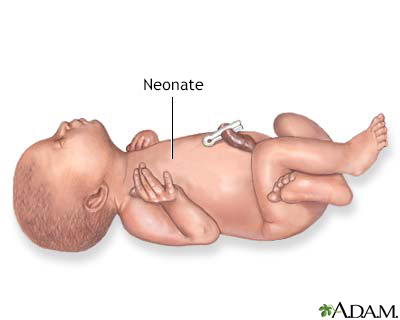Dermal melanocytosis
Mongolian spots; Congenital dermal melanocytosis
Dermal melanocytosis is the name of a kind of birthmark that is flat and blue, or blue-gray in color. They appear at birth or in the first few weeks of life. Dermal melanocytosis was formerly called Mongolian blue spots.
Images


I Would Like to Learn About:
Causes
Dermal melanocytosis is common among people of Asian, Native American, Hispanic, East Indian, and African descent.
The color of the birth mark is from a collection of melanocytes in the deeper layers of the skin. Melanocytes are cells that make the pigment (color) in the skin.
Symptoms
Dermal melanocytosis is not cancerous and is not associated with disease. The markings may cover a large area of the back.
The markings are usually:
- Blue or blue-gray spots on the back, buttocks, base of spine, shoulders, or other body areas
- Flat with irregular shape and unclear edges
- Normal in skin texture
- 2 to 8 centimeters wide or larger
Dermal melanocytosis is sometimes mistaken for bruises. This can raise a question about possible child abuse. It is important to recognize that dermal melanocytosis is a birthmark, not bruises.
Exams and Tests
No tests are needed. Your health care provider can diagnose this condition by looking at the skin.
If your provider suspects an underlying disorder, further tests will be done.
Treatment
No treatment is needed when dermal melanocytosis is a normal birthmark. If treatment is needed, lasers may be used.
Spots may be a sign of an underlying disorder. If so, treatment for that problem will likely be recommended. Your provider can tell you more.
Outlook (Prognosis)
Spots that are normal birthmarks often fade in a few years. They are almost always gone by the teen years.
When to Contact a Medical Professional
All birthmarks should be examined by a provider during the routine newborn examination.
Related Information
RashesBenign
Child physical abuse
References
Haley A, Cummings K. Dermatology. In: Anderson CC, Kapoor S, Mark TE, eds. Harriet Lane Handbook. 23rd ed. Philadelphia, PA: Elsevier; 2024:chap 8.
James WD, Elston DM, Treat JR, Rosenbach MA, Neuhaus IM. Melanocytic nevi and neoplasms. In: James WD, Elston DM, Treat JR, Rosenbach MA, Neuhaus IM, eds. Andrews' Diseases of the Skin: Clinical Dermatology. 13th ed. Philadelphia, PA: Elsevier; 2020:chap 30.
McClean ME, Martin KL. Cutaneous nevi. In: Kliegman RM, St. Geme JW, Blum NJ, Shah SS, Tasker RC, Wilson KM, eds. Nelson Textbook of Pediatrics. 21st ed. Philadelphia, PA: Elsevier; 2020:chap 670.
BACK TO TOPReview Date: 5/31/2023
Reviewed By: Ramin Fathi, MD, FAAD, Director, Phoenix Surgical Dermatology Group, Phoenix, AZ. Also reviewed by David C. Dugdale, MD, Medical Director, Brenda Conaway, Editorial Director, and the A.D.A.M. Editorial team

Health Content Provider
06/01/2025
|
A.D.A.M., Inc. is accredited by URAC, for Health Content Provider (www.urac.org). URAC's accreditation program is an independent audit to verify that A.D.A.M. follows rigorous standards of quality and accountability. A.D.A.M. is among the first to achieve this important distinction for online health information and services. Learn more about A.D.A.M.'s editorial policy, editorial process and privacy policy. A.D.A.M. is also a founding member of Hi-Ethics. This site complied with the HONcode standard for trustworthy health information from 1995 to 2022, after which HON (Health On the Net, a not-for-profit organization that promoted transparent and reliable health information online) was discontinued. |
The information provided herein should not be used during any medical emergency or for the diagnosis or treatment of any medical condition. A licensed medical professional should be consulted for diagnosis and treatment of any and all medical conditions. Links to other sites are provided for information only -- they do not constitute endorsements of those other sites. © 1997- 2025 A.D.A.M., a business unit of Ebix, Inc. Any duplication or distribution of the information contained herein is strictly prohibited.
